Skoda Kodiaq 2024 – A REUS of a Skoda! – WALKAROUND
Dimensions
The second-generation Skoda Kodiaq is 4.76 meters (+6.1 cm) long. It is 1.86 meters wide and 1.66 meters high. The wheelbase is now 2.79 meters, which is up to size. The Kodiaq comes as a five- and seven-seater. In the latter version, occupants now have 1.5 cm extra headroom. The five-seater now has a luggage space of 910 liters (+75 l). With the rear seats folded down, the volume is even 2,105 liters (+40 l). Behind the third row of seats of the seven-seater – which is not available as a plug-in hybrid – is a luggage compartment with a capacity of 340 liters (+80 l). Folding down the third row brings the volume to 2,035 liters (+30 l).
Led lighting
LED lighting is standard on every Kodiaq. Optionally, Skoda provides the new TOP LED Matrix LED headlights with optional LED connecting strip. The lighting output increased by 15%. The TOP LED lights provide a striking “four-eye look” with bi-led and matrix modules placed under each other. Each Kodiaq has interconnected LED taillights with C signature. In the more luxurious versions, the taillights also have a welcome function and dynamic turn signals. Depending on the version, the Kodiaq has alloy wheels ranging in size from 17 to 20 inches.
Lots of interior storage space
The interior of the Kodiaq is completely new. It now appears even more spacious. There are several reasons for this. The selector for the DSG transmission is now located on the steering column. This provides 2.1 liters of additional storage space in the center console. The twist-push buttons with integrated color display (Smart Dials) are also new. With a Smart Dial, the driver controls functions of his choice: from sound volume via ventilation power and smart air conditioning to driving mode and zooming in on the navigation map. Four additional physical buttons provide direct access to other climate functions, and the configurable Climate Control Menu button also makes it easy to activate and stop heating for seats, steering wheel and front and rear windows.
Virtual Cockpit for Skoda Kodiaq
The new Kodiaq comes standard with a Virtual Cockpit (10.25 inches) and a centrally located 10-inch touch display. A 13-inch screen, like a head-up display, is optional. DAB+ and voice and gesture control are standard, and four USB-C ports with enough power for charging laptops (45 W) are also included. The optional phonebox allows simultaneous wireless charging of two smartphones. The phones are cooled in the process, as this makes charging faster. Upon request, Skoda installs Ergo seats with massage function.
Also more sustainable?
In all new Kodiaq models, seat upholstery, carpeting and headliner are made of 100% recycled polyester. Recycled yarn with 40% natural wool is used in the Kodiaq Design Selection, and the leather of the ecoSuite Design Selection is tanned in an environmentally friendly way. Typical Simply Clever features such as the umbrella and ice scrapers are made from recycled materials. The convenient door guards remained. New to the Simply Clever lineup are screen cleaners for displays.


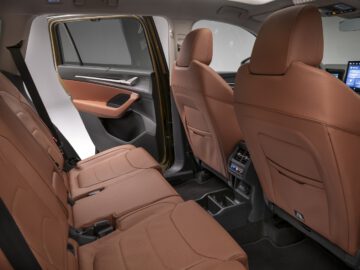
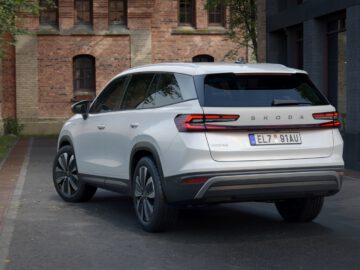
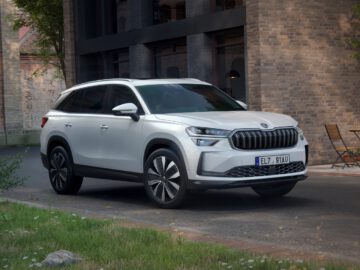
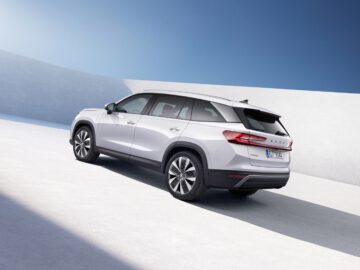
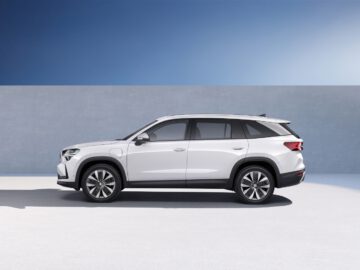

Powertrains Skoda Kodiaq
The new five-seat Kodiaq also comes with plug-in hybrid (PHEV) technology. In this process, a 1.5 TSI works together with an electric motor. System power is 150 kW (204 hp). The 27.5 kWh battery allows an electric range of 100 kilometers (WLTP), which is usually more than enough for daily use. The battery is chargeable at 11 kW (public charging points, wallboxes) and at 50 kW DC charging points.
Also as a mild-hybrid
Mild-hybrid technology is also now available. For maximum efficiency, the Kodiaq 1.5 TSI mHEV (110 kW/150 hp) uses a 48-volt belt-driven starter generator, a lithium-ion battery and the latest generation of cylinder deactivation (ACT+). The seven-passenger Kodiaq is available only with the latter powertrain. Each Kodiaq comes standard with a DSG automatic transmission.
Driver assistance systems
The new Kodiaq has many new driving assistance systems. Turn Assist warns of oncoming traffic when turning. If necessary, automatic braking follows. Collision Avoidance Assist amplifies sudden steering movements intended to swerve. Crossroad Assist uses radar technology. It warns of cross traffic, cyclists and pedestrians when exiting a (blind) driveway. Braking may also follow this. Exit warning warns of following traffic with audible and visual signals when the door is open (range: 35 meters, covered angle: 120 degrees).
Park Assist
The new, intelligent Park Assist allows the Kodiaq to park automatically. Speed and steering movements are controlled automatically. If necessary (such as an obstacle or a passing pedestrian), the car comes to a stop automatically. The system works very precisely because, in addition to sensors, it now uses a Rear View Camera. With Remote Park Assist, the Kodiaq can even be parked via app. This can be done if the driver is close to the car (max. 5 m). The app then acts as a remote control. The system can automatically stop the parking maneuver at approaching objects and traffic participants.
Side Assist and Travel Assist
Thanks to new sensors, Side Assist “sees” rear traffic as early as 90 meters away (previously 70 m). Front Assist now has an anticipatory cyclist protection feature. Travel Assist now makes nearby vehicles even more visible through the Virtual Cockpit and head-up display. Travel Assist is part of the Assisted Drive package. Included are Adaptive Lane Assist and Adaptive Cruise Control. Working with the navigation system and road sign recognition, Travel Assist can automatically adjust the car’s speed. Automated starting, braking and steering in heavy traffic (up to 60 km/h) is also possible.
Crew Protect Assist automatically closes windows and the panoramic roof (if equipped) in emergency situations. The belts are then extra tightened and the hazard lights come on. Emergency Assist reduces the risk of an accident if the rider is no longer able to drive the car, such as due to a medical emergency. If the system sees that such a situation is occurring, it makes sure the car stays in the lane, turns on the hazard lights and brings the car to a stop. Following this, the doors are unlocked, the interior lights come on and eCall makes an emergency call.

